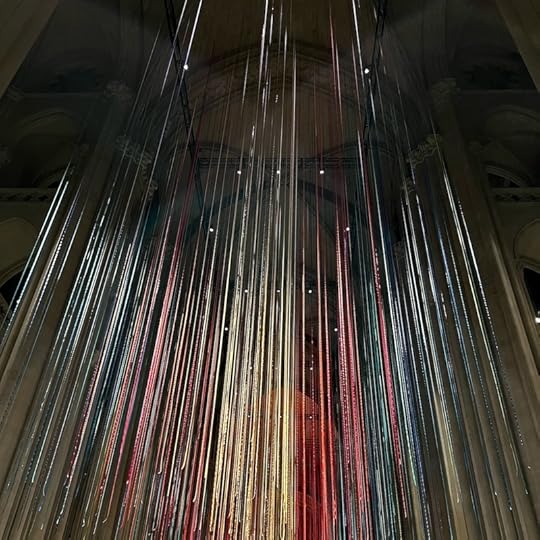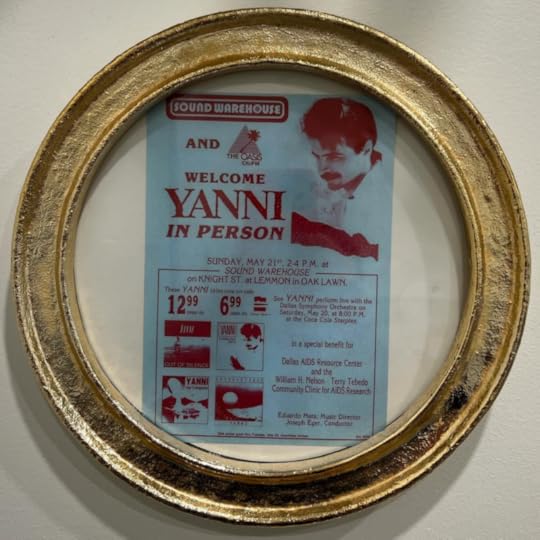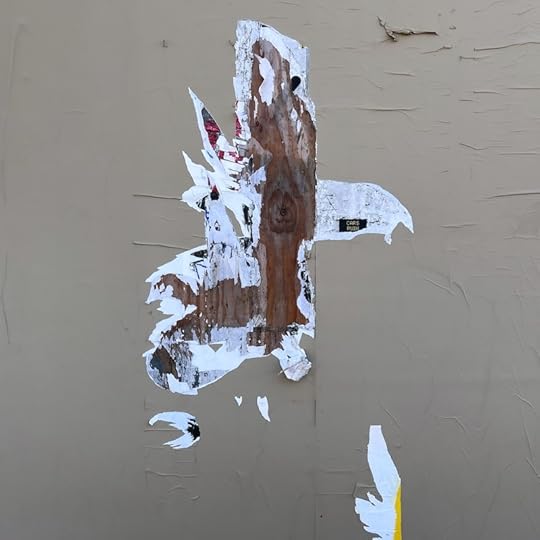Marc Weidenbaum's Blog, page 86
October 31, 2023
Sound Ledger: Leaf Blower Edition
90: Common maximum decibel level of leaf blowers
45: Decibel level of a new “ultra quiet” model called the Whisper Aero
50: The number of feet from which it is 40x quieter than ordinary leaf blowers
Source: techcrunch.com
October 30, 2023
The Heavens

Another shot from Saint John the Divine in Manhattan where I attended a fantastic choral concert a couple weeks ago
October 29, 2023
October 28, 2023
Scratch Pad: Buddha Machine, Phones, Criterion
I do this manually at the end of each week: collating (and sometimes lightly editing) most of the recent little comments I’ve made on social media, which I think of as my public scratch pad. I mostly hang out on Mastodon (at post.lurk.org/@disquiet), and I’m also trying out a few others. And I take weekends off social media.
▰ “If you would like to hold without music, please press *”
“*”
▰ Kinda stoked I passed 3,600 subscribers to my sound-studies / ambient-music newsletter, This Week in Sound
▰ Me: OK, I’ve bought enough books for the year.
Also me: Oh, there’s a new dozen ebooks selected by Nick Mamatas on Story Bundle for $20. So much for my resolve.
▰ Yeah, I bought another Buddha Machine. Couldn’t resist the 2023 edition of the debut model.
▰ It’s 2023, so one gets messages in one’s ear like: “Someone with a 415 area code has sent a thumbs-up emoji.” Even better is the odd pause between “sent” and “a” — it’s just there because that’s how the message is stitched together, but the result is like patter from the most mundane game show ever.
▰ First: Kinda obsessed with the Criterion Closet videos.
Then: Kinda obsessed with the HVAC room tone of the Criterion Closet videos.
Side note: Why hasn’t Steven Soderbergh done a Criterion Closet video?
▰ “I find music a useful distraction. A focus tool. Keeps the inner voice from wandering.”
Yeah, I’m looking forward to The Killer, the upcoming movie from David Fincher.
▰ Well, that’s one fewer social media platforms to keep an eye on: pebble.is (previously T2, its temporary name) is closing down on November 1, 2023. It was a good spot. I met some folks there, even one in real life, and we had some solid discussions going. I’m sure more such companies will fall, and rise.
▰ I’m really enjoying Duolingo (German, currently), but yow has it cut into my “pleasure reading” time
October 27, 2023
Cello Treat
The album Wave Cycles is the result of a collaboration between electronic musician Mikael Lind (a Swede based in Reykjavik, Iceland) and cellist Johanna Sjunnesson (based in Sweden), who also lends a subtly intoned vocal to one track. This is classic post-classical music: an airy combination of pulsing minimalism, often stark ambient processing, and spacious harmonies that leave plenty of room for the listener’s imagination to roam free. It has a lot of the elements one has come to expect: gaseous pauses, closely mic’d instruments, a sense of a sizable space (even if it only exists as a fiction of Lind’s digital workstation). Particularly distinguishing it are some elegant touches of percussion, as on the closing track, with which the album shares a title, and a comfort with slightly more strident tonality than post-classical music generally explores. There is a closely controlled chaos, a dangerous fuzziness, to the opening track, “In Rest and Motion,” that elevates the work considerably.
October 26, 2023
Disquiet Junto Project 0617: Haunt Scape

Each Thursday in the Disquiet Junto music community, a new compositional challenge is set before the group’s members, who then have just under five days to upload a track in response to the assignment. Membership in the Junto is open: just join and participate. (A SoundCloud account is helpful but not required.) There’s no pressure to do every project. It’s weekly so that you know it’s there, every Thursday through Monday, when you have the time and interest.
Deadline: This project’s deadline is the end of the day Monday, October 30, 2023, at 11:59pm (that is, just before midnight) wherever you are. It was posted on Thursday, October 26, 2023.
Tracks are added to the SoundCloud playlist for the duration of the project. Additional (non-SoundCloud) tracks appear in the lllllll.co discussion thread.
These following instructions went out to the group’s email list (at tinyletter.com/disquiet-junto).
Disquiet Junto Project 0617: Haunt Scape
The Assignment: Halloween is coming up. Do your thing.
There is just one step to this project: Halloween is nearly here, so make some haunted sounds for people to play for trick-or-treaters.
Eight Important Steps When Your Track Is Done:
Step 1: Include “disquiet0617” (no spaces or quotation marks) in the name of your tracks.
Step 2: If your audio-hosting platform allows for tags, be sure to also include the project tag “disquiet0617” (no spaces or quotation marks). If you’re posting on SoundCloud in particular, this is essential to subsequent location of tracks for the creation of a project playlist.
Step 3: Upload your tracks. It is helpful but not essential that you use SoundCloud to host your tracks.
Step 4: Post your track in the following discussion thread at llllllll.co:
https://llllllll.co/t/disquiet-junto-project-0617-haunt-scape/
Step 5: Annotate your track with a brief explanation of your approach and process.
Step 6: If posting on social media, please consider using the hashtag #DisquietJunto so fellow participants are more likely to locate your communication.
Step 7: Then listen to and comment on tracks uploaded by your fellow Disquiet Junto participants.
Step 8: Also join in the discussion on the Disquiet Junto Slack. Send your email address to marc@disquiet.com for Slack inclusion.
Note: Please post one track for this weekly Junto project. If you choose to post more than one, and do so on SoundCloud, please let me know which you’d like added to the playlist. Thanks.
Additional Details:
Length: The length is up to you.
Deadline: This project’s deadline is the end of the day Monday, October 30, 2023, at 11:59pm (that is, just before midnight) wherever you are. It was posted on Thursday, October 26, 2023.
Upload: When participating in this project, be sure to include a description of your process in planning, composing, and recording it. This description is an essential element of the communicative process inherent in the Disquiet Junto. Photos, video, and lists of equipment are always appreciated.
Download: It is always best to set your track as downloadable and allowing for attributed remixing (i.e., a Creative Commons license permitting non-commercial sharing with attribution, allowing for derivatives).
For context, when posting the track online, please be sure to include this following information:
More on this 617th weekly Disquiet Junto project, Haunt Scape (The Assignment: Halloween is coming up. Do your thing), at: https://disquiet.com/0617/
The cover image (enlarged, type added) is from Wikipedia:
https://en.wikipedia.org/wiki/Skull#/media/File:3d_CT_scan_animation.gif
That image is credited to Arielinson and used thanks to a Creative Commons Attribution-Share Alike 4.0 International license: https://creativecommons.org/licenses/by-sa/4.0/deed.en
About the Disquiet Junto: https://disquiet.com/junto/
Subscribe to project announcements: https://tinyletter.com/disquiet-junto/
Project discussion takes place on llllllll.co: https://llllllll.co/t/disquiet-junto-project-0617-haunt-scape/
October 25, 2023
New York’s Alright
I just returned home to San Francisco after 11 days in New York, much of it on Long Island with extended family, and a third of the trip in the city proper — hotel in Manhattan, wanderings through Brooklyn and Queens. I got as far north as 155th Street, in order to catch a fantastic concert of choral music at the massive Cathedral Church of Saint John the Divine. I am currently in my tiny office getting work done while listening to (and occasionally taking a peek at) an uncut, multi-hour recording out a window onto the city. (Some straightforward sleuthing seems to confirm it was shot — roughly southward-facing — on 52nd Street between Broadway and 8th Avenue, perchance not far from where I stayed. I walked close by a few days earlier on my way to Hell’s Kitchen for dinner.) The experience is oddly centering, maybe even assisting by taking the edge off the brain-melting jet lag I’ve experienced since my return Monday night. I recommend tuning in at the 27-minute mark to hear a street musician’s saxophone echo upward, bouncing off of — and in turn softening — the city’s hard surfaces. I listened to it on headphones for quite a while. However, it really took root — really came alive — when I unplugged my ears and let the sounds fill the room: the honking, the chatter of passersby, the air traffic, the congealed hum of urban life in the single densest city in the United States, and that saxophone. This is room sound, and it makes sense in a room: the audio of one place transported to — superimposed atop — another.
October 24, 2023
In Person

This is on the wall in the men’s room at my favorite Greek restaurant in my hometown where I’ve been eating since I was in high school, maybe junior high
October 23, 2023
“In One Place (Second Attempt)”
I recorded this in an apartment I was staying at in New York. It was early in the day. I was the only one up. I had another hour before my solitude was scheduled to be interrupted. The building’s HVAC each night disturbed my sleep, but as with a nightmare, those same sounds were tranquil, even beautiful, come morning. I had attempted another 30-second recording before this one. While it was underway I noted several disappointing disturbances — creaks and pops, the aural detritus of a building waking up. Apart from them I heard an extraordinary spatial drone, a manifestation of overtones, a symbiosis of modern domestic infrastructure and a room of high ceilings, a hard floor, and a wall of glass at one end. When the first attempt ended, I took a slow, deep breath and hit record. I knew in the moment that it would work out well. There is something of Schrödinger’s cat to the act of field recording. A place is many places when you listen to it over time, but when you hit record, it gets clarified (reduced, flattened, distilled) to one specific environment. This can feel like an exertion of influence when you undertake the recording process consciously, when you have situated yourself in the moment. I felt a kind of authorship as the second recording was underway. It was precisely what I had heard beneath the extraneous noises the first time. After 30 seconds had elapsed, I ceased recording. I had a sense it had worked out, a sense confirmed many hours later, when I listened back for the first time, on the flight home. Just minutes after this recording ended, the room went suddenly silent. The air conditioning system had reached a point — whether barometric or calendrical — that caused it to shut off. Minutes later, the lawnmowers began their prowling. I had been even more fortunate than I’d known when I hit record that second time.





